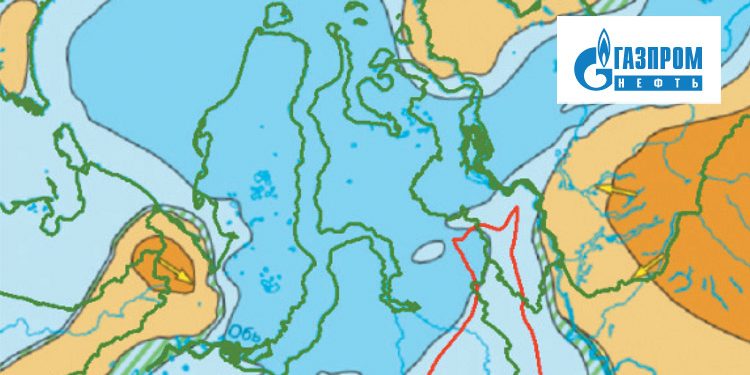Gazprom Neft: Western Siberia Structural Features of the Taz Khet Facies
Data relating to the deposits discovered in the Pur-Tazov oil and gas bearing region (Fig. 1) suggest that the deposits located here have a high hydrocarbon potential and a significant oil bearing section. As Fig. 1 shows, the main prospects in this area are related to the Upper Jurassic complex with its complex structures.
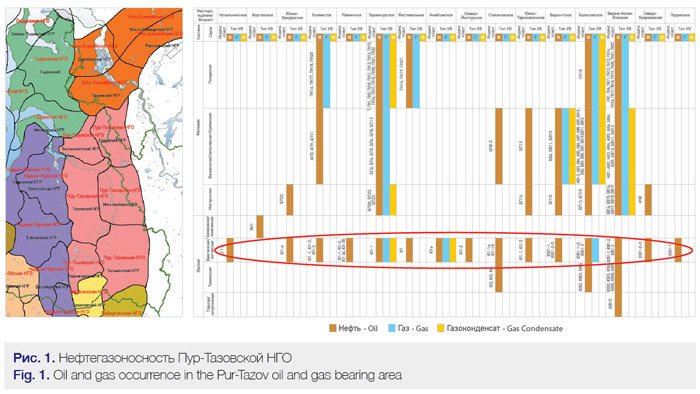
The structure and the oil and gas bearing capacity in the Upper Jurassic Complex of the Western Siberia Region, and its eastern edge in particular, has at different times provoked the interest in a number of academics. The authors believe it is necessary to briefly highlight the work of those researchers whose studies provide the best and most accurate information about the basic structure of the deposits explored. A. A. Nezdanov in his paper [1] describes the clinoform structure of the Upper Jurassic deposits in the North East of the Western Siberian area (Fig. 2). According to Nezdanov, the sand deposits are concentrated in the upper part of the Kimmeridgian seismic cyclothem clinothem, and they extrapolate towards an area where the general density declines, to the west. In Western Siberia, he identified three region-specific three region-specific transgressive-regressive cyclothems types: the Vasyugan (Callovian and Oxfordian) cyclothem, the Georgiev or Upper Sigovo (Kimmeridgian) cyclothem, and the Yanov Stan (a Tithonian stage or partially the Berriasian?) cyclothem.
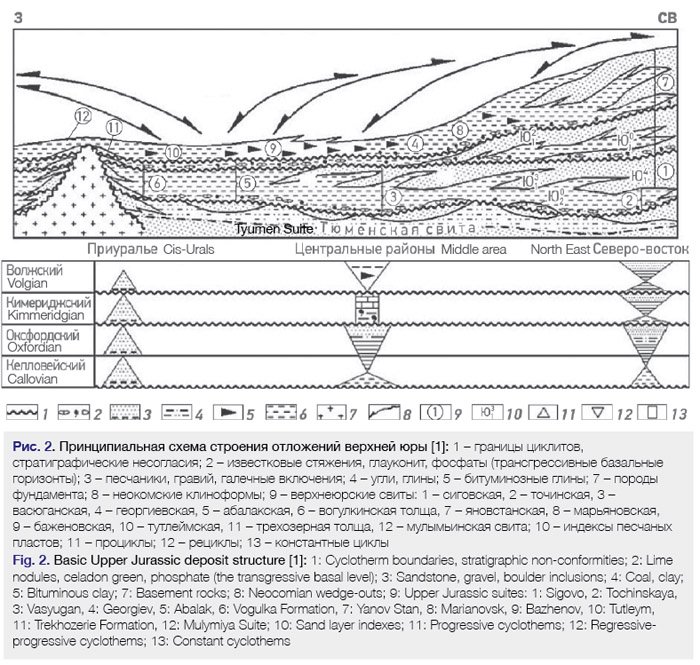
In the authors’ view, the best quality paleogeographic plotting maps covering the period of the Upper Jurassic deposit accumulation are those of the Novosibirsk Petroleum Geology and Geophysics Institute. They are based on integrated paleontological and stratigraphic, lithologic, and geochemical surveys of the deep well core samples and natural rock outcrops along with detailed seismic stratigraphic analyses (Fig. 3).
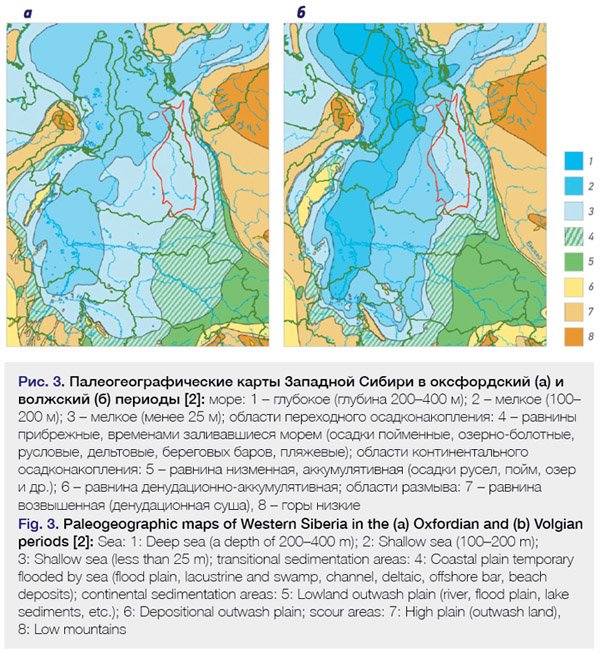
Fig. 3 shows the distinctive features of the Oxfordian age geography in the prevailing marine sedimentation, and mainly in the shallows. The climate in the southern and middle part of the Western Siberia was semi-arid with prevailing humid conditions in the north. The Sigovo Suite sand, silt, and clay with numerous inclusions of marine fauna residues developed in the north east part of the shallow sea water area, immediately including the Pur-Tazov oil and gas bearing area deposits. In the late Oxfordian age long-term transgression commenced, the largest in the entire Jurassic period.
The Late Jurassic transgression reached its maximum in the Volgian age (see Fig. 3 б). During the Volgian age, the sea occupied most of the Western Siberian geo-syneclise. The basin continued intensively and asymmetrically to sag. The deposits of the Bazhenov Suite, was later to became the major oil source formation for the entire Western Siberia, accumulated in the middle part of the region [2]. The Yanov Stan Suite of finely dispersed and silty clay types evolved in the basin’s north east during the Volgian age.
Discussion
Seismic facies and paleotectonic survey, as well as the geophysical survey and core sample results were carried out in the aims of developing a conceptual model of the Upper Jurassic complex.
RE-CREATION OF THE FORMING PROCESSES FOR EACH LAYER IN THE UPPER JURASSIC COMPLEX WAS MADE POSSIBLE BY PALEOTECTONIC RECONSTRUCTION. DENSITY ANALYSIS HELPED TO IDENTIFY THE FACIES ENVIRONMENT AND THE APPROXIMATE MAPPING OF THE FACIES ZONE BOUNDARIES.
As shown in the structural facies zoning diagram for the Callovian and Upper Jurassic deposits in the Western Siberia [3], the Pur-Tazov oil and gas bearing area encompasses as many as three facies areas: the Frolov Tambey, Purpey Vasyugan, and Taz Khet areas.
This article predominantly covers the least researched Upper Jurassic deposits of the easternmost Taz Khet structural facies area. From a stratigraphic point of view, the Upper Jurassic deposits in this area belong to the Yanov Stan and Sigovo Suites. In order to construct a sedimentation model for the Upper Jurassic complex in the east part of the Western Siberia basin, it was decided to rely on the top down approach: to study the complex structure within the entire area first, and then drawn conclusions about its forming mechanisms and the distinctive features of the area in question. To this end, a full scope of the geological information and the detailed and regional seismic survey results was studied.
One of the distinctive features of the Upper Jurassic deposits identified in this area is the increase in their total density with increased sandiness in the east direction at the transition from the Purpey Vasyugan facies area to the Taz Khet facies area. The seismic data interpretation also suggests that chronological thicknesses sharply rise to east, within the considered region, and a large number of non-elongated reflections appear between the reflecting interfaces adjacent to the Upper Jurassic complex boundaries.
The major difficulty in constructing a regional model for the Upper Jurassic layers lies in the varying levels of knowledge about them. The Group Yu1 Vasyugan Suite layers in the middle of the area with the greatest oil and gas bearing potential have been relatively well studied. However, permeability and porosity, the forming mechanisms, and the distribution pattern of the Upper Jurassic layers in the Taz Khet facies area where they feature the Sigovo and Yanov Stan deposits are in general under-researched.
A distinctive feature of the Georgiev and Bazhenov horizon is the way in which they change; their thickness increases to the east while the interlayer bitumen impregnation falls. To the east of Western Siberia, the Georgiev Suite changes into the deposits of the Yanov Stan Suite with its section featuring the YaN1-6 sand layers; they are also characterized by a regional increase in the number of clayish formations from east to west, up to their full disappearance resulting in lower total suite thickness [4].
Within conceptual modeling, a detailed correlation has been developed for the Upper Jurassic complex using wells located in different parts of the Taz Khet and Purpey Vasyugan lithologic and facies areas. Presumed isochronal boundaries were used to track the layers, while taking cyclogenesis into account [5]. This allowed the conclusion that the Group Yu1 layers within the Vasyugan Suite and the Group SG within the Sigovo Suite developed in varying facies conditions, but within the framework of a single sedimentation cycle. The Yanov Stan Suite deposits developed in an environment characterized by sea progradation with simultaneous accumulation of Georgiev and Bazhenov clay.
Recreating the formation processes for each layer of the Upper Jurassic complex was made possible by paleotectonic reconstruction [6]. Thickness analysis allowed the identification of the facies environment and approximate mapping of the facies zone boundaries (Fig. 4).

According to regional concepts about the Western Siberia structure, early in the Upper Jurassic development process, the main provenance area was located in the east and south east. Sediments gradually moved to the sedimentation basin with the river and fluvial flow. Once in the marine sedimentation environment, the majority of the material almost immediately settled, thus forming thick sand deposits in the foreshore and pre-shore facies, as reflected by the log curve shape of the Sigovo Suite. More finely grained material was carried up the sedimentation basin, thus forming the Vasyugan Suite deposits widely featured in the middle of the Western Siberia syneclise, as the transitional area and shallow sea shelf facies. This flow direction is evidenced by the core sample material, the analysis of which revealed a notable increase in the Vasyugan Suite clay facies versus the Sigovo Suite. As a result of a massive Western Siberia basin transgression in the late Oxfordian age, the sand material supply to the area was interrupted. Thus, the sand layers in the Upper Jurassic deposits within this area developed in regressive-transgressive conditions when the sedimentation basin grew slowly; the facies zones shifted forwards relative to the sea movement; and the sandy sediment sequence appeared in the section.
A distinctive feature of the regional structure of deposits in the Upper Jurassic is the junction zone between the Purpey Vasyugan and Taz Khet areas which serves as a hypothetic lithologic and facies screen for coeval deposits in the complex in question. In this zone the beach particles change into the sea shelf particles in the Sigovo and Vasyugan Suites, which itself serves as a lithologic boundary to prevent the sand layers within the Yanov Stan Suite from spreading (see Fig. 4).
Based on their research, the authors have identified a range of crucial patterns for the Upper Jurassic deposits:
» The regional provenance area for the sedimentation material of the sedimentary mantle deposits in the Taz Khet structural facies area was the Siberian platform sediments
» The Upper Jurassic complex deposits within the Taz Khet structural facies area are of coastal genesis
» The Oxfordian and Kimmeridgian sand deposit thickness successively rises from the middle part of Western Siberia to its eastern edge
» The net-to-gross sand ratio for the Upper Jurassic complex increases in the east direction
» The permeability and porosity of the Upper Jurassic reservoirs improve from the middle of the Western Siberia oil and gas bearing area to its east
THE REDUCTION IN SUBSURFACE UNCERTAINTY AND THE DIVERSIFICATION OF INVESTMENTS IN FIELD CLUSTER MAKE INTEGRATED TAZ KHET STRUCTURAL FACIES AREA PROJECTS QUITE APPEALING.
The above distinctive features of the Upper Jurassic complex structure may have both a positive and negative impact on hydrocarbon deposit forming within the boundaries of the area under study. This, in the author’s opinion, is quite logical.
The seemingly positive impact of improved reservoir properties or a boost in net-to-gross ratio at the project site, in particular, leads to unrestricted hydrocarbon migration from the lower laying to the upper laying formation. At the same time, widespread cap rock seal sanding and irregular thickness negatively influence the deposit formation and preservation in the Taz Khet area.
Lack of source rock in the lithologic and stratigraphic section also has a negative role in creating deposits of the Taz Khet area. Indeed, according to the regional process of catagenesis, the organic matter at the top of the Upper Jurassic deposits in the Western Siberia within the area under study, went through an early stage of mesocatagenesis only, and was unable to generate sufficient hydrocarbons to fill all potentially promising traps within the Taz Khet structural facies area. It is probably that most hydrocarbons emerged in the middle part of the basin and then partially migrated to its east, where they filled the possible traps.
Summarizing the above, the promising Upper Jurassic complex deposits within the Pur-Tazov oil and gas bearing area appear to possess high subsurface risks in terms of creating hydrocarbon deposits.
Exploration for unique or large oil fields in this area is unlikely to be successful. More probable is the discovery of a large number of small, very small and a certain number of medium-sized fields. It should be noted that the almost perfect compliance of probabilistic methods used here demonstrates the correct use of methodology and the high quality of the results obtained.
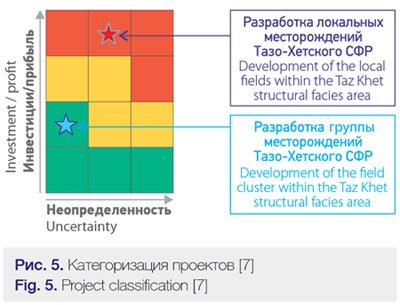
Conclusion
It is possible to assess the investment potential of the Taz Khet structural facies area, using the Gazprom Neft classification for exploration and production as a basis (see Fig. 5). We will review the case for exploration and bringing into production the local oil fields at the eastern edge of the Western Siberia. First, we should consider the high subsurface risks mentioned above, which magnify the subsurface uncertainty; secondly, the low likelihood for discovering large or unique oil fields dramatically reduces the chance of making a high profit; and thirdly, the area’s infrastructure is poorly developed.
Therefore, the development of local fields within the Taz Khet structural facies area appears to hold little promise from the point of view of the investment project evaluation matrix.
In the author’s opinion, the only way to bring the resources of the area under study into production is to develop integrated field cluster projects. A large part of the investments required for such projects would be allocated for exploration. Significant investments in exploration will reduce subsurface risks and thus limit uncertainty. The discovery of a small to medium oil field cluster, which is quite likely, will provide considerable reserves, and its development will increase profit. In place of local field development, regional infrastructure centres are proposed which will support hydrocarbon transportation and operation for a number of small and medium oil fields. In this way, the reduction of subsurface uncertainty and the diversification of investments in the field cluster make the integrated Taz Khet structural facies area projects quite appealing.
References
1. Nezdanov A. A. (2004). Geoseismic Analysis of the Gas and Oil Bearing Deposits in the Western Siberia to Forecast and Map the and HC Deposits (Geological and mineralogical science doctoral dissertation). Tyumen
2. Kontorovich A. E., Kontorovich V. A., Ryzhkova S. V. et al. (2013) Jurassic Paleogeography in the Western Siberia Sedimentary Basin. Geology and Geophysics, Vol. 54 (Issue 8), 972–1012.
3. SNIIGGiMS. (2004). Resolution of the 6th Interdepartmental Stratigraphic Meeting for Review and Adoption of the Refined Stratigraphic Diagrams for the Mesozoic Deposits of the Western Siberia. Novosibirsk, 114 p.
4. Ampilov Yu. P. (2008). From Seismic Interpretation to Modeling and Evaluation of Oil and Gas Fields. Moscow: Spektr, 384 p.
5. Muromtsev V. S. (1984). Electrometric Geology of Sand Bodies, Lithologic Oil and Gas Traps. Moscow: Nedra, 260 p.
6. Neyman V. B. (1984). Theory and Methodology of Paleotectonic Analysis. Moscow: Nedra, 80 p.
7. Khafizov S. F., Istomina I. V., Bochkov A. S. et al. (2015). Guidelines for Exploration. Izhevsk: Computer Research Institute, 288 p.
Authors of the article: M.V. Bukatov, S. V. Mikhailova, Gazprom Neft Research and Development Centre (Gazprom Neft NTC, LLC).
Published with thanks to Gazprom Neft & PROneft Magazine

